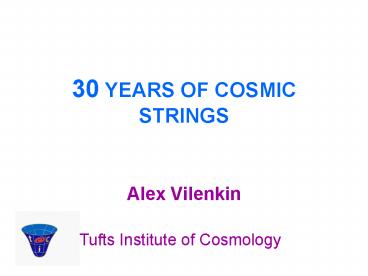30 YEARS OF COSMIC STRINGS - PowerPoint PPT Presentation
1 / 25
Title: 30 YEARS OF COSMIC STRINGS
1
30 YEARS OF COSMIC STRINGS
- Alex Vilenkin
Tufts Institute of Cosmology
2
30 YEARS OF COSMIC STRINGS
String evolution
FOCUS ON
Detection (bounds)
3
30 YEARS OF COSMIC STRINGS
LEAVE OUT
Superconducting strings Vortons Semilocal
strings String formation Strings in GUTs Strings
in condensed matter
4
A BRIEF HISTORY
Publications per year
Kibble 1976
5
OLD STRING EVOLUTION SCENARIO
Kibble (1976), A.V. (1981)
- Distance between strings
- Loop sizes
- Loops decay by gravitational radiation
Mass per unit length of string
6
THE FIRST COSMIC STRING REVOLUTION
7
High-resolution simulations the loops are tiny
(below the resolution)
rad. matter
Small-scale wiggles
Bennett Bouchet (1990) Allen Shellard (1990)
Loop sizes are set by the scale of wiggles.
8
SCENARIOS
is determined by gravitational back-reaction
Bennett Bouchet (1990)
(standard model)
Siemens Olum (2001) Siemens, Olum A.V. (2002)
No scaling
Vincent, Hindmarsh Sakellariadou
(1997)
Observational predictions are sensitive to !
9
THE SECOND COSMIC STRING REVOLUTION
(still in progress!)
10
Small-scale wiggles and loops are resolved!
Ringeval, Sakellariadou Bouchet (2005)
Most of the energy goes Into loops with
. Requires
a cutoff.
Shellard Martins (2005)
Loop formation on scales .
Radiation era
Olum Vanchurin (2006)
Scaling peak in loop production develops at after
a long transient regime.
11
Flat-space exact simulation
Vanchurin, Olum A.V. (2005)
after a long transient regime.
12
The picture that seems to emerge is close to the
old string scenario
(?)
Broad distribution of loops and small-scale
wiggles.
13
Analytic models
Kibble (1985) Bennett (1986) Copeland, Kibble
Austin (1992) Martins Shellard (1996)
Copeland, Kibble Steer (1998) Polchinski
Rocha (2006)
To reach full understanding, we will need to
combine numerical and analytic techniques.
14
COSMIC SUPERSTRINGS
Witten (1985) Sarangi Tye (2002) Majumdar A.
Davis (2002)
F, D and FD strings FD networks.
Copeland, Myers Polchinski (2004) Dvali A.V.
(2004)
Metastable, but the lifetime can be gtgt 1010 yrs.
In models of brane inflation
.
Jones, Stoica Tye (2003)
Similar range in hybrid inflation GUT models
Jeannerot Postma (2005)
Reconnection probability may be small
.
Jackson, Jones Polchinski (2004)
15
How does affect string evolution?
Simple argument suggests Numerical evidence is
inconclusive.
Sakellariadou A.V. (1990) Sakellariadou (2005)
Avgoustidis Shellard (2006)
But in any case, for p ltlt 1 there is a large
number of strings per Hubble volume.
Direct observational test of string theory.
16
EVOLUTION OF FD-NETWORKS
Scaling
Vachaspati A.V. (1987) McGraw (1998) Tye,
Wasserman Wyman (2005)
Simple models
depends on energy dissipation.
Goldstone radiation
Spergel Pen (1997) Copeland Saffin
(2005) Hindmarsh Saffin (2006)
Global string network simulations
If the dominant energy loss is gravitational
radiation
String domination
17
Gauge strings
Urrestilla
U(1)xU(1)
Loop production?
Scaling
18
OBSERVATIONAL BOUNDS
19
STRING SIGHTINGS
Cowie Hu (1987)
Sazhin et. al. (2003)
Schild et. al. (2004)
20
GRAVITATIONAL RADIATION
Stochastic GW background GW bursts from
cusps.
Comparable power in bursts and in low harmonics.
Vachaspati A.V. (1984) Hogan Rees
(1984) Caldwell Allen (1992) Battye,
Caldwell Shellard (1996)
Bursts may be detectable for
.
Damour A.V. (2000,2005)
Better for p ltlt 1.
Siemens et. al. (2006) Hogan (2006)
LIGO search is underway!
21
BOUNDS FROM PULSAR OBSERVATIONS
8 yrs
Kaspi, Taylor Ryba (1994)
17 yrs
Lommen (2002) Hogan (2006)
(disputed)
PTA
Jenet et. al. (2006)
(Pulsar Timing Array)
Full PTA
(20 pulsars for 5 yrs)
22
Implications of large loops
Nucleosynthesis bound
Vanchurin, Olum A.V. (2005)
Reionization
loops seed early galaxy formation.
Olum A.V. (2006)
23
CMB BOUNDS
CMB anisotropies
Pogosian, Wasserman Wyman (2006)
CMB polarization
B-type polarization due to vector perturbations
induced by strings.
may be detectable.
Seljak Slosar (2006)
24
Bad news GUT-scale strings
are ruled out.
We are not likely to detect strings through
gravitational lensing or CMB anisotropies.
Constraint is much weaker for global strings
Good news strings can be detected well
below the GUT scale.
Gravitational waves, CMB polarization
25
CONCLUSIONS
A new generation of string simulations is
underway. Strong indications of loop scaling
(?) important
observational implications.
The strongest present bound on strings
(PTA)
The most promising detection methods pulsar
timing, GW bursts, CMB polarization. May get to
in 5 yrs.
The field is as vibrant as ever!

